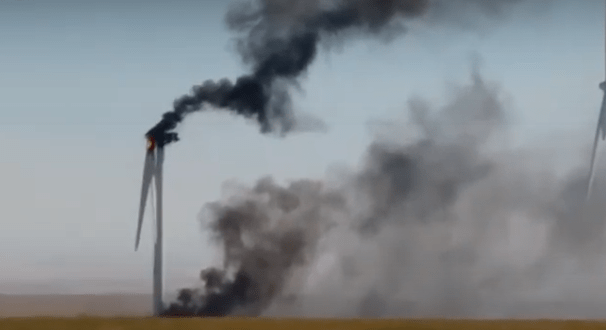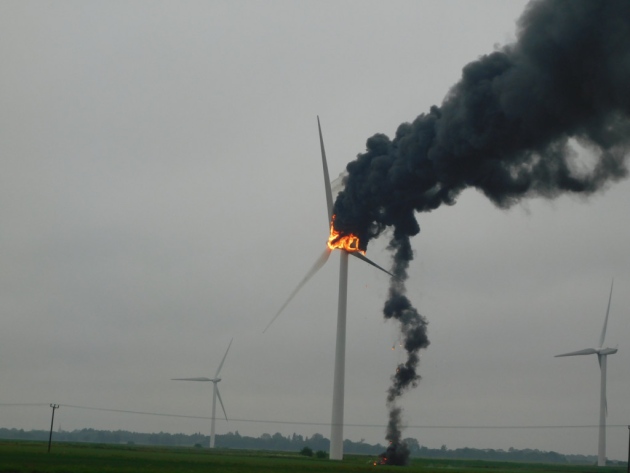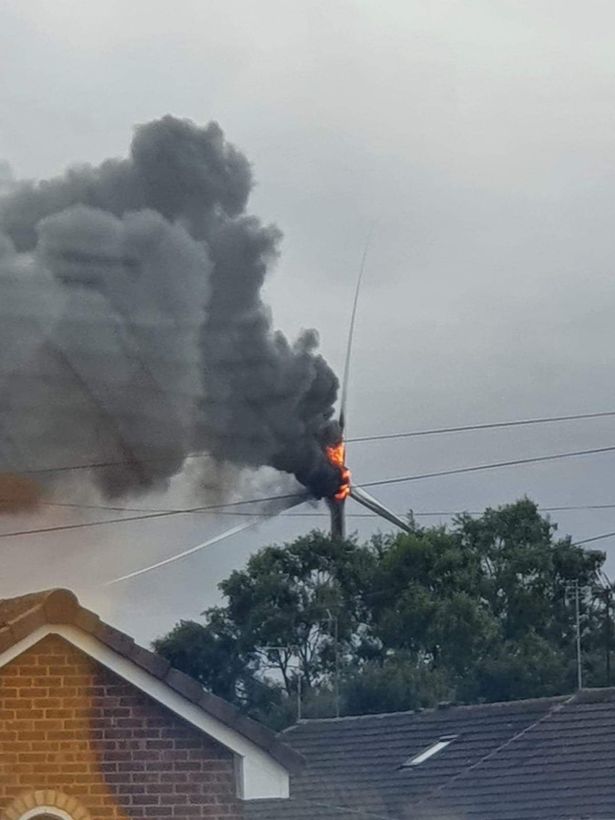Efforts to portray wind turbines as ‘safe’, ‘clean’ and ‘green’ are undone by their reputation for spectacular pyrotechnic displays whenever they decide to self-immolate and turn themselves into terrifying, toxic fireballs.
Around the world, hundreds have exploded into in palls of toxic smoke and balls of flame – in the process – each one raining molten metal and over 1,000 litres of flaming gear oil and hydraulic fluid (see our post here) and burning plastic earthwards.
Wind turbine fires are ten times more common than the wind industry and its spin doctors claim (see our post here and check out this website: http://turbinesonfire.org).
In the second article below it’s reckoned that: “The rate of fires has remained consistent over the past decade according to available data. Typically one in every 2,000 turbines will burn down every year.” With hundreds of thousands of these things now speared into communities all over the world, that’s an awful lot of free pyrotechnics in the offing.
This time the unscheduled fireworks display takes place in Hull, in the UK.
Hull wind turbine fire witnesses feared blades would collapse during ferocious blaze
Hull Daily
Ivan Morris Poxton
3 August 2022
Witnesses working near a blazing wind turbine have told how they were worried the eight tonne blades would collapse on top of them.
Large plumes of smoke and fire could be seen emerging from the 125 metre tall wind turbine at the former Croda factory in Oak Road, in north Hull on Wednesday morning shortly after 7am. The blades could still be turning as the fire took hold. Humberside Fire & Rescue attended the scene.
It is unclear what impact the fire has had on the structural integrity of the huge turbine tower and its eight -tonne blades assembly. Police closed the scene to the public as burning debris started falling onto Oak Road Playing Fields and a nearby industrial site. Croda Chemicals sold their Hull site to Cargill on June 30, and have offered support to those working at the scene. The company has also confirmed there are “no reported injuries” as the fire eventually burned itself out.
A large plume of smoke was seen by members of the public leaving the turbine by at least 7.25am on Wednesday morning. The fire appeared to spread further along as the turbine continued to rotate.
Witness Shaun Casey who works in an industrial estate very close to the turbine told BBC Humberside Radio: “We saw the smouldering just after 7am. We started evacuating just for safety and then the flames started and everyone was evacuated from the site. It was quite horrendous to watch to be honest.
“There was no explosion but the flames got quite intense. We were quite fearful that it was going to drop. We were all evacuated from the site and we could see the bits dropping (fibreglass). All the cars have quite a lot of debris on them. A bit worried that it actually comes off.
“We were very surprised to see it. I was just really fearful it was going to drop and because of what’s next to it, possible explosions.”
Humberside Fire & Rescue Service issued a statement at 7.44am and confirmed a crew was at the scene: “CONTROL – We are receiving multiple calls regarding a fire involving the wind turbine on Oak Road fields between Clough Road and Sutton Fields in Hull. Crews are in attendance.” The fire was successfully put out in the morning by 9am.
A Croda International plc spokesperson said: “We can confirm that we are aware of an incident at the Cargill site in Oak Road, Hull, involving a wind turbine fire at approximately 08.30 today. On 30 June 2022, Croda International Plc completed the sale of the majority of its Performance Technologies and Industrial Chemicals businesses to Cargill, which included the Hull site.
“We have been in contact with Cargill and have offered support. There have been no reported injuries. Croda erected the wind turbine in 2008 and maintained the turbine using third party wind turbine experts.”
A site worker told Hull Live that a drone was seen overhead at about 9am and staff were allowed back on site at 9.15am. “I’m not sure if this has anything to do with it, but the turbine was making a louder noise than usual yesterday,” said the worker. They added that workers were concerned about the possible environmental impact if part of the structure fell, with the River Hull adjacent to it and it was “a blow” to Cargill to happen barely a month since buying the site.
Phil Drew, from the offshore training provider HOTA located nearby, is a former firefighter. He said to the BBC: “The fire has been dealt with, there’s nothing left to burn fortunately. The outside nacelle is there, the blades are still intact. It was relatively big. It was the nacelle that was primarily involved, spreading to the front and it started travelling up the blades.
Hull Daily News
Hull wind turbine blaze ‘likely to have been caused by an electrical or mechanical fault’
Hull Daily News
Angus Young
3 August 2022
Today’s spectacular wind turbine fire at Cargill’s Hull factory is likely to have been triggered by either an electrical or mechanical fault.
The huge turbine was installed in early 2008 by the site’s then owners Croda International after securing planning approval the year before. At the time it was Hull’s first large wind turbine.
Until then, similar onshore wind farm developments in the East Riding had featured clusters of between seven and nine turbines in open countryside designed to feed power to the National Grid. In contrast, the Croda scheme broke new ground by using a single turbine to generate power for a specific industrial site in an urban setting.
Standing 125 metres tall, it became an instant landmark on the city’s horizon with a maximum capacity of generating two million watts of power. That’s enough to run 1,000 electric toasters simultaneously.
Although the cost of the development was not revealed at the time, similar-sized single turbine installations usually cost around £2.8m at today’s prices. The typical operational lifespan of a modern wind turbine is 25 years so, by that measure, the Hull turbine was already middle-aged before today’s fire started.
It’s clear from the images of the blaze that it was largely confined to the nacelle which is the casing sitting on top of the turbine tower. This houses gears which convert the relatively slow rotation of the spinning blades into higher-speed motion and the generator which acts like a giant version of a dynamo on a bicycle by generating electricity through the movement of the rotor blades.
Industry experts say turbine fires typically happen because of an electrical or mechanical fault leading to ignition which spreads to the surrounding plastics and the nacelle itself which is made from fibreglass. Experts examining the aftermath of today’s blaze will try to pinpoint the specific area where it started.
Transformers in the turbine converting energy into voltage are one potential point of ignition if an electrical fault is confirmed. Similarly, a mechanical fault in the nacelle’s emergency braking system could have also been responsible as the deployment of brakes to stop the blades rotating generates both friction and heat.
Angela Krcmer, global sales director at wind turbine fire safety firm Firetrace International, recently highlighted the issue in an article for Power Engineering International. She said: “The wind industry has underestimated fire risk for decades.
“For a time, the industry could get away with not fully managing fire risk, as the size and number of assets per owner were low enough for many to not experience a fire in their portfolio. However, as turbines begin to scale up and wind takes on a greater share of national energy mixes across Europe and North America, the industry cannot afford the financial and reputational damage that even a single turbine fire can bring.
“The rate of fires has remained consistent over the past decade according to available data. Typically one in every 2,000 turbines will burn down every year.
“While technologies which are less susceptible to fire such as electric braking systems have been developed, many of the key ignition points are necessary for electricity generation and as such, cannot be designed out of the turbine. While the frequency of fires has remained constant over the years, the financial risk of fire has increased with the size and complexity of turbines. As turbines are getting increasingly bigger and therefore more expensive, a single fire can have a much greater impact.”
The fire will almost certainly mean the turbine will have to be dismantled. With each blade weighing just over 8,000kg, that’s likely to be a big job.
As the site’s new owners, Cargill will also be responsible for overseeing an in-depth investigation into the cause of the blaze, The sale of the chemicals complex was only completed in late June and previous owners Croda have offered their support. In a statement, Croda said it had used an external specialist company to maintain the turbine.
Hull Daily News






Even in wind-obsessed Germany, it’s now illegal to place a wind turbine within two kilometers of a village or woodlot.
So, fires happen even though turbine manufacturers use the powerful greenhouse gas sulfur hexafluoride
to prevent fires. Sulfur hexafluoride (SF6) is far more
toxic to climate than CO2 (26,087 times more harmful)
leaks from gear box in turbine. Remains in atmosphere
for thousands of years.
Solar modules fires more common
Solar modules made in China are more dangerous. More wildfires.